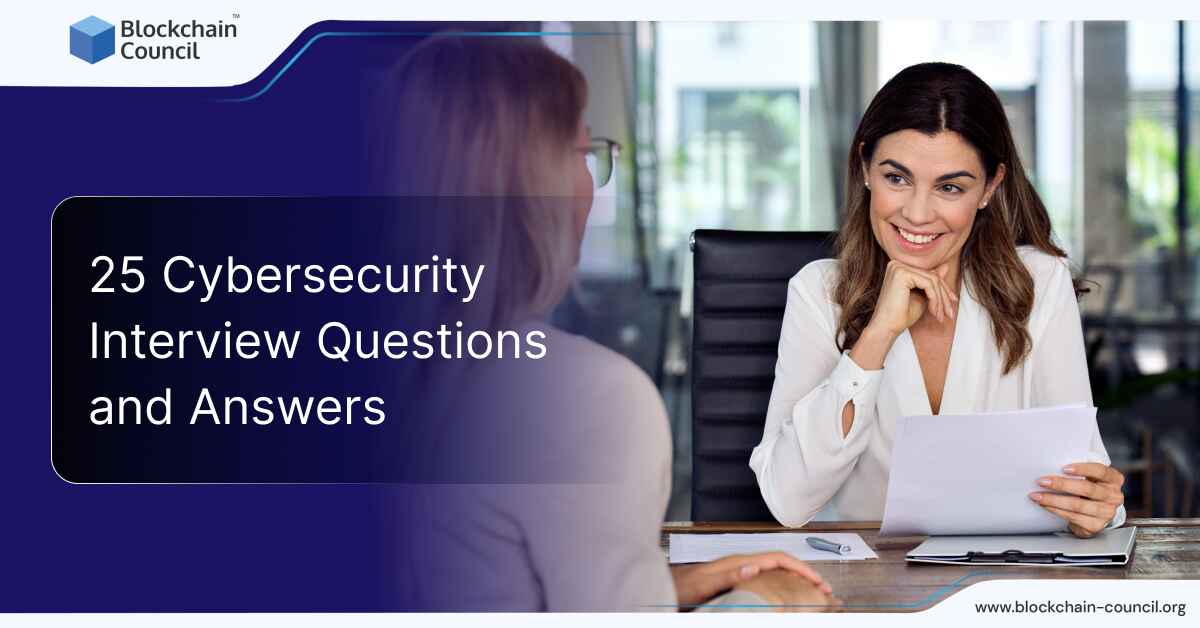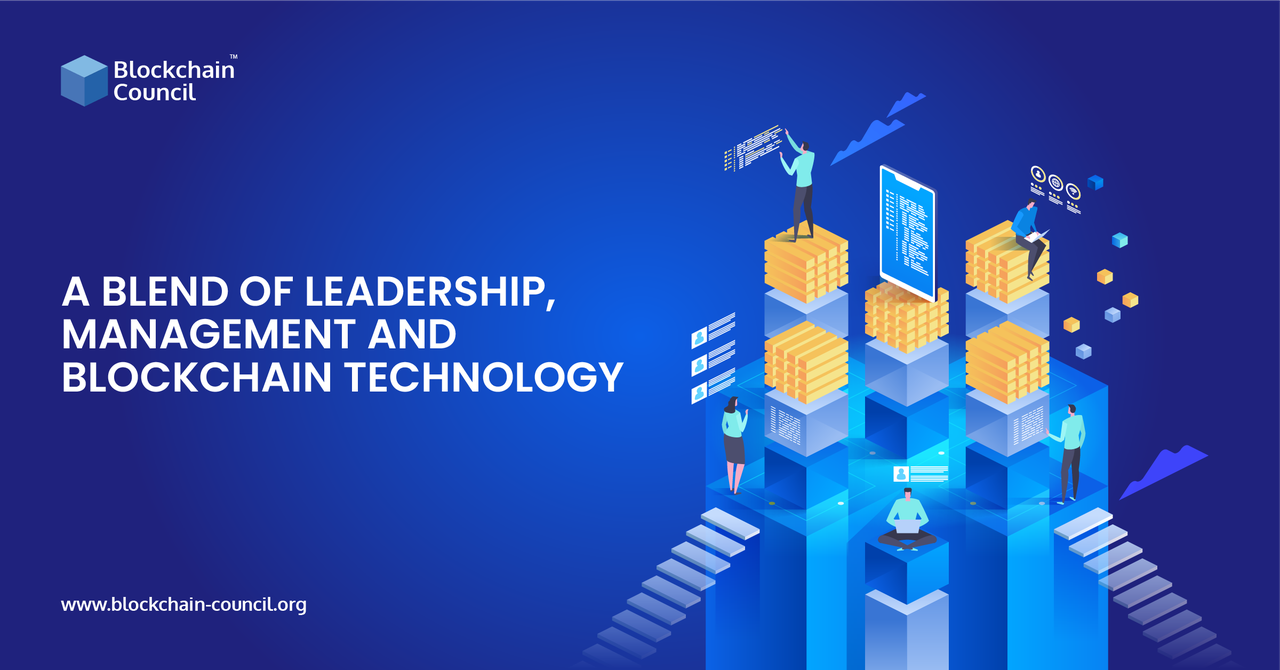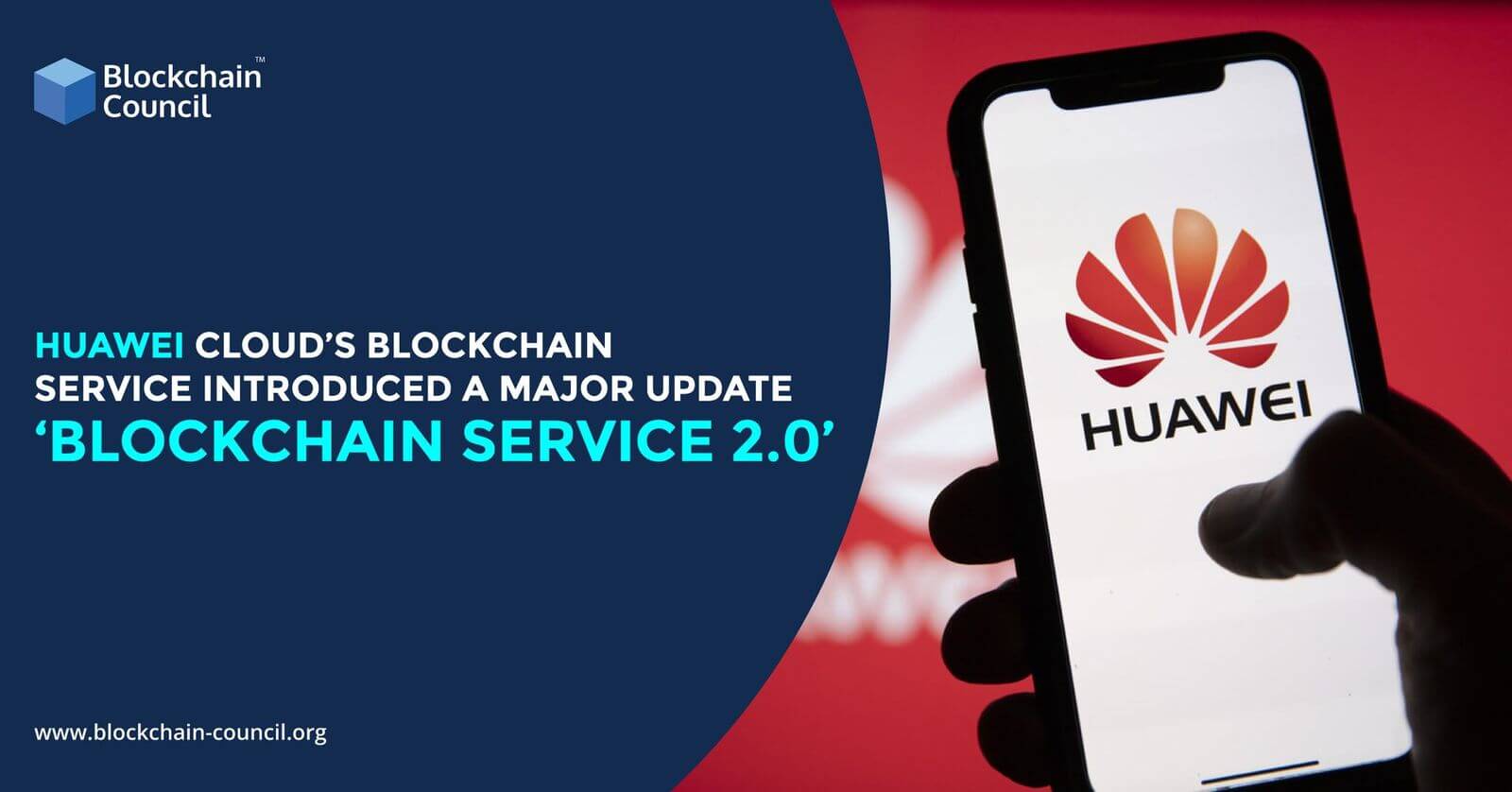
- Blockchain Council
- January 03, 2025
Top 25 Cyber Security Interview Questions and Answers
Section 1: Basic Cybersecurity Concepts
Q1: What is cybersecurity?
Cybersecurity encompasses the techniques and practices designed to protect critical systems, devices, and sensitive data from cyberattacks. It’s a critical discipline that spans from personal to corporate security measures, safeguarding valuable information against unauthorized access and cyber threats.
Q2: What are common cybersecurity terms one should know?
Essential cybersecurity terms include:
- Network: An interconnected group of digital devices sharing resources and information.
- IP Address: A unique numerical label for each device on the internet.
- VPN (Virtual Private Network): A secured internet connection ensuring data privacy.
- Firewall: A security system monitoring network traffic to block unauthorized access.
- Encryption: Scrambling data to prevent unauthorized interpretation.
- Data Breach: An incident where confidential information is accessed without authorization.
Q3: What is the CIA triad in cybersecurity?
The CIA triad stands for Confidentiality, Integrity, and Availability – three foundational principles of cybersecurity. Confidentiality ensures data privacy, integrity assures data accuracy and protection against tampering, and availability guarantees that data and systems are accessible to authorized users when needed.
Q4: What are common types of malware?
Common malware types include:
- Trojan Horses: Malicious software disguised as legitimate.
- Viruses: Programs designed to corrupt or destroy data.
- Spyware: Software used to spy on user activity.
- Worms: Self-replicating malware spreading through networks.
Q5: How does ransomware work?
Ransomware is a type of malware that encrypts or locks personal files, with the attacker demanding a ransom to restore access. It’s a serious threat, with incidents resulting in significant financial demands from victims.
Section 2: Technical Skills and Knowledge
Q6: Explain the process of a penetration test.
A penetration test follows a systematic approach, beginning with scoping and defining the test objectives. It includes reconnaissance to gather information on potential vulnerabilities, which leads to an attempt to exploit these weaknesses to gain unauthorized access. The test concludes with a comprehensive report detailing the findings and recommendations for remediation, thus bolstering application security and cyberattack defense.
Q7: What does the reconnaissance stage of penetration testing involve?
In the reconnaissance stage, ethical hackers aim to uncover vulnerabilities and security gaps in the target system. They analyze the target’s infrastructure, online presence, and security measures using various data collection tools and techniques, setting the stage for simulating real-world attacks.
Q8: Describe the target discovery and development phase in penetration testing.
This phase is focused on enumerating all potential targets and evaluating the effectiveness of existing security controls. It involves researching and exploiting known vulnerabilities, and may include social engineering to access sensitive information. This helps identify security gaps and strengthens the overall security posture.
Q9: What happens during the exploitation stage of penetration testing?
Security professionals utilize specialized tools to exploit identified vulnerabilities, aiming to gain unauthorized access and assess the system’s security posture. They test security measures’ effectiveness, which helps understand the potential attack surface and any existing security vulnerabilities.
Q10: What is involved in the escalation stage of penetration testing?
The escalation stage involves elevating privileges within the target system, testing lateral movement within the network, and attempting to bypass security systems like firewalls. This critical stage identifies security vulnerabilities and evaluates the target’s defenses’ overall strength.
Section 3: Advanced Cybersecurity Topics
Q11: Discuss the implications of quantum computing on cybersecurity.
Quantum computing marks a significant paradigm shift from classical computing by leveraging quantum mechanics to perform calculations at unprecedented speeds. This advancement is set to revolutionize various sectors, including cybersecurity. Quantum computers, through their ability to perform complex calculations swiftly, present a dual-sided impact on cybersecurity. They have the potential to enhance security protocols but also pose significant threats, particularly to cryptographic standards like RSA and ECC. The power of quantum computers to decrypt currently secure data in a fraction of the time poses an urgent call to action for cybersecurity professionals to reassess and fortify cryptographic frameworks in anticipation of quantum capabilities.
Q12: What are the emerging threats from quantum computing to current cybersecurity mechanisms?
The introduction of quantum computing into the cybersecurity landscape reshapes the perception of digital threats. The ability of quantum computers to break public-key cryptography, which forms the bedrock of secure communications and data protection, is a primary concern. Algorithms like Shor’s pose a direct threat to RSA encryption, potentially making current encryption techniques obsolete. Moreover, quantum computing also challenges the integrity of hash functions, crucial for data authentication and integrity. Financial institutions, government agencies, and healthcare providers handling sensitive data could find their protocols vulnerable, necessitating a redesign of cryptographic systems to withstand quantum threats.
Q13: What is quantum-resistant cryptography, and why is it important?
Quantum-resistant cryptography, also known as post-quantum cryptography (PQC), is a new breed of cryptographic systems designed to be secure against the formidable capabilities of both classical and quantum computer attacks. The goal of PQC is to develop cryptographic systems impervious to quantum computing threats. Initiatives like the National Institute of Standards and Technology’s (NIST) post-quantum cryptography standardization project are pivotal in guiding the future of cryptography and setting a global benchmark for cybersecurity practices. Lattice-based cryptography, hash-based cryptography, and multivariate polynomial cryptography are a few approaches that show promise in being resistant to quantum attacks.
Q14: How can businesses prepare for the cybersecurity challenges posed by quantum computing?
Businesses must adopt a proactive strategy to prepare for the quantum era, which includes conducting comprehensive quantum risk assessments, early adoption of quantum-safe cryptography, staying informed about rapid developments in the field, and investing in advanced solutions like Quantum Key Distribution (QKD). Collaborative efforts and compliance with emerging standards and regulations will be critical in navigating this transition. This proactive stance is not only about defense but also about seizing the opportunity to innovate and gain a competitive advantage in the evolving technological landscape.
Q15: What strategic measures can ensure resilience against quantum threats?
To ensure resilience against quantum threats, businesses should engage in quantum risk assessments to identify vulnerable areas, prioritize upgrades to quantum-safe solutions, incorporate PQC algorithms into their security infrastructures, and remain agile in their cybersecurity strategies. Collaboration across industries, compliance with regulatory guidelines, and investments in technologies like QKD are also strategic measures that can fortify a business’s cybersecurity posture against the inevitable advent of quantum computing.
Section 4: Practical and Scenario-Based Questions
Q16: How would you handle a data breach?
Handling a data breach requires a prepared and prompt response. The first step is to identify and contain the breach, followed by a thorough investigation to determine its scope and impact. Communication is key; stakeholders and affected parties must be informed appropriately. It’s crucial to also engage with legal counsel to understand any regulatory requirements. Lastly, reviewing and updating security measures to prevent future incidents is essential. A step-by-step guide, such as the Experian Data Breach Response Guide, can provide valuable insights and best practices for creating and testing a successful response plan, offering perspectives on current cybersecurity trends and how different industries can be impacted by data breaches.
Q17: In the event of a ransomware attack, what steps should an organization take?
For a ransomware attack, the initial step is to isolate the infected systems to prevent further spread. The next course of action is to assess the damage and determine if decryption without paying the ransom is possible, often with the assistance of cybersecurity experts. Companies should then determine whether to engage with law enforcement and consider the implications of paying the ransom. Critical data should be restored from backups where available, and a thorough post-incident analysis should be conducted to reinforce defenses against future attacks.
Q18: Describe the decision-making process when choosing cybersecurity solutions for a company.
Choosing cybersecurity solutions involves assessing the company’s specific needs, considering factors such as the size of the company, the nature of the data handled, and compliance requirements. It’s important to prioritize solutions that address the most significant risks and provide a strong return on investment. Involving stakeholders from various departments, including IT, legal, and operations, is also key to ensure the solutions align with broader business objectives. Regularly reviewing and updating the cybersecurity strategy is crucial as new threats emerge and the company evolves.
Q19: How can an organization effectively test its cybersecurity incident response plan?
An effective test of a cybersecurity incident response plan involves conducting regular drills and simulations that mimic real-world scenarios. These exercises should involve all relevant personnel and departments to ensure a coordinated and efficient response. Analyzing the response to these drills, identifying gaps, and refining the plan is an ongoing process. Additionally, it’s beneficial to stay informed about the latest cybersecurity incidents in the industry to update the response plan with any new best practices.
Q20: What factors should be considered when determining the cybersecurity budget for an organization?
Determining a cybersecurity budget requires evaluating the potential risks and the costs associated with a data breach, including regulatory fines, loss of customer trust, and business disruption. It should also reflect the value of the data and assets being protected. The budget should account for proactive measures like employee training, regular penetration testing, and updating security technologies. Balancing cost with the level of security needed and the potential impact of a breach on the organization’s operations and reputation is crucial.
Section 5: Soft Skills and Ethics in Cybersecurity
Q21: How do you stay updated with cybersecurity knowledge?
Staying updated in the cybersecurity field requires a proactive approach to continuous learning. This can be achieved through various means such as subscribing to cybersecurity publications, attending workshops and conferences, participating in webinars, and engaging with online communities and forums. It’s also beneficial to follow thought leaders and influencers in the field, and engage in hands-on practice through labs and simulations. Continuous learning is vital due to the rapidly evolving nature of cyber threats and technologies.
Q22: Discuss an ethical dilemma you might face in cybersecurity.
An ethical dilemma in cybersecurity could arise when handling sensitive data breaches. A professional may need to decide between disclosing a vulnerability immediately to protect users or delaying disclosure to prevent informing potential attackers. In such cases, the cybersecurity professional must weigh the potential harm against the benefits of early disclosure, always prioritizing the privacy and security of users while adhering to legal and regulatory requirements.
Q23: Why are soft skills important in cybersecurity?
Soft skills are crucial in cybersecurity for effective team collaboration, leadership, and communication of technical details to non-technical stakeholders. They help in managing stress during high-pressure situations like cyberattacks and breaches, and in meticulously developing strategies to counteract sophisticated cybercriminals. Ethics and honesty establish trust with employers and clients, ensuring integrity in all cybersecurity practices.
Q24: How can cybersecurity professionals demonstrate composure under pressure?
Cybersecurity professionals can demonstrate composure under pressure by maintaining a calm demeanor during crisis management, effectively prioritizing tasks, and making sound decisions swiftly. Regular training and simulations of breach scenarios can help professionals build resilience and the ability to navigate stressful situations confidently and competently.
Q25: Explain the role of teamwork and communication in cybersecurity.
Teamwork and communication are the bedrocks of successful cybersecurity operations. Cybersecurity challenges are complex and require diverse skill sets; thus, professionals must work cohesively within their teams and communicate effectively across departments. Collaboration is key to developing and implementing robust security policies, and clear communication is necessary for educating employees about security best practices and for reporting to stakeholders during and after security incidents.
Conclusion
In conclusion, as we step into 2025, the importance of cybersecurity cannot be overstated. The digital landscape continues to evolve rapidly, and cyber threats are becoming more sophisticated. Cybersecurity is not just a buzzword; it’s a critical shield that protects our digital identity, finances, and privacy.
In this article, we have explored 25 pertinent interview questions and answers related to cybersecurity. We have covered basic cybersecurity concepts, technical skills and knowledge, advanced topics, practical scenarios, and soft skills and ethics in cybersecurity.
The evolving landscape of cybersecurity highlights the need for constant vigilance and adaptability as cyber threats become more complex. Ransomware, social engineering tactics, and the potential misuse of artificial intelligence are just a few of the challenges we face in 2025.
To stay ahead in this ever-changing field, organizations must adopt proactive cyber strategies and stay updated with current trends. Certifications like the Certified Cybersecurity Expert™ by the Blockchain Council can be beneficial to land a high-paying cyber security job. As we move forward, the collaboration of cybersecurity professionals, the development of quantum-resistant cryptography, and the importance of teamwork and communication will be instrumental in protecting our digital assets and privacy in an increasingly connected world.
Disclaimer: The content on this platform is for educational purposes only. We do not endorse, recommend, or promote any product. Our articles are based on data from trustworthy sources, and our perspective is neutral and unbiased. Readers should make informed decisions and seek professional advice when needed. We have no affiliations with the products or services mentioned in our content.
Frequently Asked Questions
What is cyber security, and why is it important in 2025?
- Cyber security involves techniques and practices to protect systems, devices, and sensitive data from cyberattacks.
- It is crucial in 2025 due to the rapidly evolving digital landscape and the increasing sophistication of cyber threats.
- Cybersecurity safeguards digital identity, finances, and privacy for both individuals and organizations.
- It spans from personal to corporate security measures, defending against unauthorized access and cyber threats.
How has the cyber security landscape evolved up to 2025?
- The cybersecurity landscape has transformed due to technological advancements and the ingenuity of malicious actors.
- Ransomware continues to be a global threat, growing in complexity and size.
- Collaboration among threat actors and socially engineered tactics have become more refined.
- The potential misuse of artificial intelligence is a significant concern, with large language models capable of spreading misinformation and carrying out cyberattacks.
What are the implications of quantum computing on cyber security in 2025?
- Quantum computing can perform complex calculations swiftly, impacting cybersecurity positively and negatively.
- It poses a threat to existing cryptographic standards like RSA and ECC, making them vulnerable.
- Quantum-resistant cryptography (post-quantum cryptography) is crucial to defend against quantum threats.
- Businesses must conduct quantum risk assessments, adopt quantum-safe solutions, and stay informed about developments in the field.
Why are soft skills important in cyber security?
- Soft skills are vital for effective teamwork, communication, and ethical practices in cybersecurity.
- They help manage stress during high-pressure situations such as cyberattacks and breaches.
- Professionals can demonstrate composure by maintaining a calm demeanor, prioritizing tasks, and making sound decisions swiftly.
- Regular training and simulations of breach scenarios can build resilience and confidence in navigating stressful situations in cybersecurity.





































































 Guides
Guides News
News Blockchain
Blockchain Cryptocurrency
& Digital Assets
Cryptocurrency
& Digital Assets Web3
Web3 Metaverse & NFTs
Metaverse & NFTs
